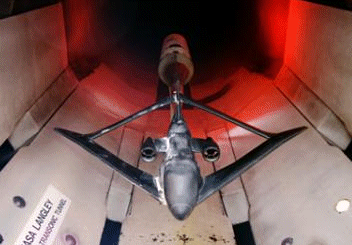Graham Warwick/WASHINGTON DC
A proposal to modify a Lockheed S-3 Viking to flight test a joined-wing airborne surveillance configuration is among nine projects selected for further study under NASA's Revolutionary Concepts (RevCon) programme.
The contractor teams and NASA centres involved will now conduct parallel feasibility studies leading to selection next June of "three or four" projects for flight demonstration, says RevCon programme manager Jerry Malcolm.

Led by Boeing, the joined-wing integrated structures project involves an S-3-based piloted demonstrator with radar apertures integrated into the four joined wings. The configuration promises to reduce weight and drag, improving speed and endurance, with the large apertures increasing radar range and resolution.
The other projects selected are:
· An unmanned, subscale variable diameter tiltrotor demonstrator. Led by Sikorsky, this project offers performance improvements and noise reductions from changing blade length in flight to optimising the proprotor for hover and cruise conditions, Malcolm says.
· A two-dimensional, mixed compression engine inlet for a supersonic transport will be flown on a Lockheed SR-71 to demonstrate technology for reducing the sonic boom to a level that will allow supersonic flight over land. An infrared laser radar sensor will be used to detect turbulence ahead of the aircraft and adjust the inlet to avoid an engine stall. Lockheed Martin and Gulfstream, who are working together on a supersonic business jet, are involved.
· The Revolutionary Propulsion for Aeronautics Vehicles project involves the demonstration of a pulse-detonation afterburner on one General Electric F110 engine in a Boeing F-15. This concept promises increased thrust and improved fuel efficiency.
· A variable-area fan nozzle for commercial turbofans using smart-material actuation will be demonstrated in a project led by United Technologies. Electrically signalled, shape-memory-alloy actuators will allow up to 20% nozzle area change to optimise the engine for take-off and cruise, Malcolm says, with modest thrust vectoring for attitude control.
· The Smart Vehicle project will demonstrate hingless aerodynamic effectors that increase manoeuvrability while reducing signature. An unmanned demonstrator based on a Firebee drone will test flow-control devices such as inflatable flaps, pulsed-jet vortex generators and "actuated passive porosity". The project involves Lockheed Martin.
· The Swashplateless Flight project will replace the mechanical swashplate used to control helicopter rotor-blade pitch with individually controllable, electro- mechanically actuated on-blade flaps, to improve redundancy and reduce noise and vibration. An unmanned ATI UltraSport helicopter will be flown first in a two-blade configuration and then with four blades, says Malcolm.
· Reliable autonomous control of air vehicles will be demonstrated in a project which will apply NASA's autonomous spacecraft technology to unmanned air vehicles in a bid to provide mission reliability equivalent to manned aircraft.
· NASA's ongoing APEX project to validate technology for high subsonic, high-altitude aircraft, using an unmanned glider released from a balloon at 100,000ft (30,500m), is also up for funding through RevCon.
The RevCon programme is intended to accelerate work on high-risk "breakthrough" technologies by funding flight demonstrations under costing-sharing agreements with industry. NASA is already funding three projects through last year's Quickstart effort to get the programme underway. These are: a subscale model of the Boeing Blended Wing Body transport, set to fly in 2002; a flight test of a pulse-detonation engine on an F-15 or SR-71 in 2002; and a demonstration of autonomous close-formation flight in 2001, using two Boeing F/A-18s.
Source: Flight International
















